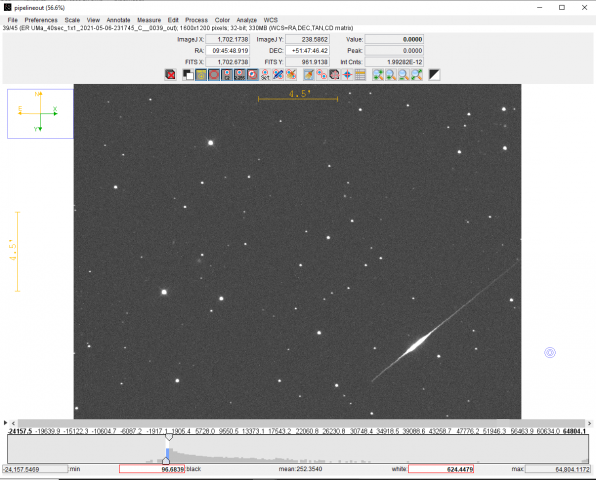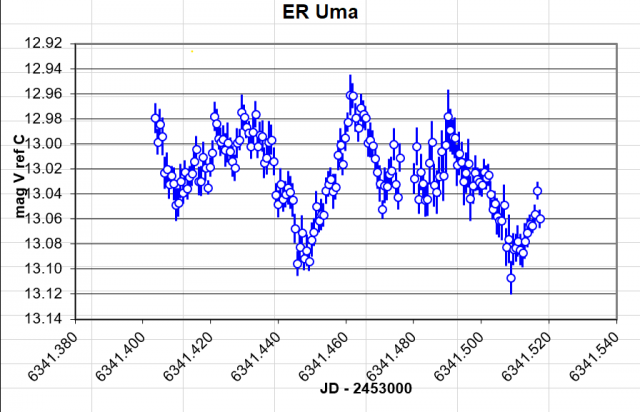› Forums › Variable Stars › ER Uma and RZ Lmi: Observations requested.
Tagged: ER UMa
- This topic has 43 replies, 7 voices, and was last updated 3 years, 5 months ago by
 Richard Sargent.
Richard Sargent.
-
AuthorPosts
-
6 May 2021 at 10:07 am #584179
 Graeme CoatesSpectator
Graeme CoatesSpectatorForecast looks OK for me this evening – I’ll have a go if OK.
6 May 2021 at 11:52 am #584180 Stewart John BeanParticipant
Stewart John BeanParticipantContinues to look like a superoutburst. Stewart
6 May 2021 at 11:47 pm #584182 Graeme CoatesSpectator
Graeme CoatesSpectatorCurrently 13.0-13.1CV (21:40-22:20UT on 6th May 2021). Answers on a postcard for this intruder…
 7 May 2021 at 9:44 am #584183
7 May 2021 at 9:44 am #584183 Graeme CoatesSpectator
Graeme CoatesSpectatorAppears to show superhumps with period similar to the published 91.67min (going from the minima). Data in BAA VSS database for analysis. Got hindered by next door’s greengage tree, and software hang at the end…
(Clear filter with V comparison stars used. 40sec each, ST2000XM+350mm Newt @ f4.52)
 7 May 2021 at 4:45 pm #584184
7 May 2021 at 4:45 pm #584184 Stewart John BeanParticipant
Stewart John BeanParticipantThey look good to me. Variation of about 0.15 mag is about right for superhumps, i think. So it all fits.
Thanks , Stewart
7 May 2021 at 9:50 pm #584185 Maxim UsatovParticipant
Maxim UsatovParticipantER UMa May 7.2837 2021 V = 13.08 ± 0.03
23 June 2021 at 10:45 am #584386 Stewart John BeanParticipant
Stewart John BeanParticipantER Uma was at quite dim last night at 15.0 V mag. It is also approaching time for the next superoutburst as the last one started around JD 2459338. With a super outburst period of 55 +_ 5 days, this minimum may be the last before a normal outburst triggers the superoutburst. A few extra observations in the next 5 days could capture the event nicely.
Thanks in advance.
Stewart
23 June 2021 at 11:19 pm #584387 Graeme CoatesSpectator
Graeme CoatesSpectatorER UMa appears in outburst this evening:
Jun 23.907UT – 12.83CV
24 June 2021 at 11:43 am #584389 Tim HaymesParticipant
Tim HaymesParticipantI also find the variable bright at r 12.88 +/-0.05 (Unfiltered CCD, GaiaDR2/Astrometrica). Poor conditions of drifting high cloud in Moonlight Measurement were from start, mid and end of a frame sequence at 5s intervals for 20min.
25 June 2021 at 8:58 pm #584393 Stewart John BeanParticipant
Stewart John BeanParticipantDefinitely in outburst and possibly this will trigger the superoutburst. The last superoutburst was recorded, at its brightest at 12.2 visual, by OJR (AAVSO) on 2459339. So we are ~50 days later right now. Could well brighten over the next day or two.
Stewart
28 June 2021 at 6:40 pm #584401 Stewart John BeanParticipant
Stewart John BeanParticipantIts a difficult target right now!
29 June 2021 at 2:54 pm #584404 Stewart John BeanParticipant
Stewart John BeanParticipantI used iTEL 18 last night to get a time series. VPhot reports the V filter magnitude dropping from 13.15 to 13.3 over 13 minutes. The variation may be related to the orbital period of 90 min or the change in skyglow in the dusk sky. Going to repeat tonight but starting a bit later. Stewart
1 July 2021 at 9:51 am #584406 Stewart John BeanParticipant
Stewart John BeanParticipantThe present superoutburst seems to have been recorded first by Graeme Coates and Tim Haymes on the evening of the 23rd June. This translates to a superoutburst period of 51 +-1 day which is right in the middle of the range of values from 45 to 55 days discussed in VSSC188.
Thanks again to Graeme and Tim and all other contributors.
This target is now really difficult and June has previously marked the end of the observing season. In October the whole cycle begins again with a possible superoutburst around Oct 1. Can this one be observed?
Stewart
19 September 2021 at 6:27 pm #584695 Stewart John BeanParticipant
Stewart John BeanParticipantAAVSOnet telescopes in New Mexico have made two observations of ER UMa this week marking the start of this star’s observing season. As noted above, the next superoutburst may be around Oct 1 but could be later by a week or so as ER Uma does appear to vary its super cycle period between 45 and 55 days.
For UK observers, the star is very low in the north by north west sky in the evening. In the unsociable early morning, it does rise about 30 degrees above the horizon before dawn.
More details on ER UMa were presented in VSS Circular 188.
30 November 2021 at 3:25 pm #584947 Stewart John BeanParticipant
Stewart John BeanParticipantAs mentioned by Jeremy in VSSC 190 (the latest) several ER UMa stars are due a superoutburst before the year end. With a disclaimer on the accuracy of the dates, I copy below my expectations for four stars.
Superoutburst period (d) Next superoutburst (give or take a few days)
RZ LMi 25 Dec 11 Late evenings
V1159 Ori ~50 Dec 22 A late evening target
IX Dra 60 Dec 30 An early evening target
ER Uma 50-55 Dec 30 – Jan 2 Late evening target
Stewart
30 November 2021 at 10:15 pm #584952 Jeremy ShearsParticipant
Jeremy ShearsParticipantLooks like a busy December, Stewart!
14 December 2021 at 5:35 pm #585016 Stewart John BeanParticipant
Stewart John BeanParticipantMy prediction was one day early, but that is consistent with the superoutburst period very gradually getting larger. The last period was 26 days as I judge it.
Actually, this seasons light curve has good coverage as Sjoerd Dufoer (BE) has made 52 observations. Gary Poyner and Raymond Pearce have contributions as well. Thanks to all three.
Stewart
28 December 2021 at 10:58 am #585049 Stewart John BeanParticipant
Stewart John BeanParticipantMeasured ER UMa at 12.9 CV on 2021/12/28 03:08:50 using SLOOH in the Canaries. Hopefully some more results will arrive to refine the timing of what appears to be a superoutburst.
This is only ~45 days after the start of the last one. Most periods lie in the range 45 to 60 days – so quite short. See VSSC188 for a full graph of super cycle period over the last 200 or so cycles for context.
Stewart
11 May 2022 at 8:07 pm #610260 Stewart John BeanParticipant
Stewart John BeanParticipantER UMa is likely to go into superoutburst in the next few days. The last superoutburst started at 2459660. The superoutburst period varies between 45- 55 days. It is now 50 days since the last outburst.
Further observations this week would be timely.
Stewart
12 May 2022 at 8:29 pm #610298 Richard SargentParticipant
Richard SargentParticipantAttachment shows measurements of ER UMa from a 2 hour period starting at approximately 22.00 hours UT last night. Each point is a block average of 6 ten second images.
Attachments:
-
AuthorPosts
- You must be logged in to reply to this topic.

